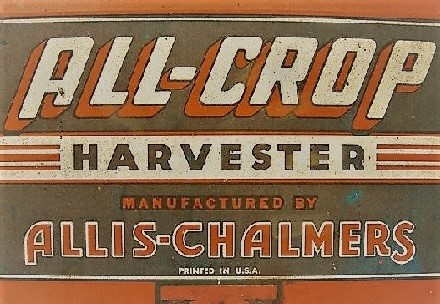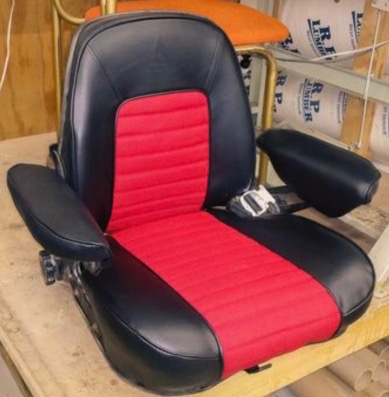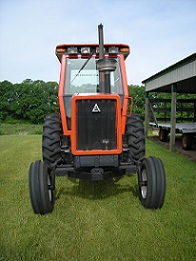| Author |
 Topic Search Topic Search  Topic Options Topic Options
|
nick121 
Silver Level


Joined: 13 Apr 2016
Location: ontario
Points: 322
|
 Post Options Post Options
 Thanks(0) Thanks(0)
 Quote Quote  Reply Reply
 Topic: Older diesel engines that smoke? Topic: Older diesel engines that smoke?
Posted: 05 Jan 2017 at 6:13pm |
|
Just curious as to why some of the older diesel smoke as much as they do? In older gleaners they smoke.. my F2 with 4 cylinder smokes a bit.. The N6 gleaners smoke too. My 7040 tractor doesn't but I have seen some that do. Also the Massey Ferguson 750/850 with the 354 always seem to smoke. Is it because of over fueling to try and get the most horsepower? Is it the timing? I'm just trying to learn a bit more about diesels.
|
 |
|
Sponsored Links
|
|
 |
DougS 
Orange Level


Joined: 03 Nov 2011
Location: Iowa
Points: 2490
|
 Post Options Post Options
 Thanks(0) Thanks(0)
 Quote Quote  Reply Reply
 Posted: 05 Jan 2017 at 6:15pm Posted: 05 Jan 2017 at 6:15pm |
|
I suspect that it's a combination of excess fuel and lower compression.
|
 |
caledonian 
Silver Level Access


Joined: 02 Apr 2016
Location: Nebraska
Points: 470
|
 Post Options Post Options
 Thanks(0) Thanks(0)
 Quote Quote  Reply Reply
 Posted: 05 Jan 2017 at 6:24pm Posted: 05 Jan 2017 at 6:24pm |
|
I'm no expert but I alway's thought it was because they turned the pump up. And older pump's weren't as efficient as they are today. Someone else who know's more please chime in.
|
 |
Larry in NC 
Orange Level

Joined: 09 Feb 2016
Location: NC
Points: 1050
|
 Post Options Post Options
 Thanks(0) Thanks(0)
 Quote Quote  Reply Reply
 Posted: 05 Jan 2017 at 6:35pm Posted: 05 Jan 2017 at 6:35pm |
|
Usually white smoke is oil consumption and black smoke is fuel. I have a Massey Ferguson that has blow by and puffs white smoke from the exhaust.
|
 |
nick121 
Silver Level


Joined: 13 Apr 2016
Location: ontario
Points: 322
|
 Post Options Post Options
 Thanks(0) Thanks(0)
 Quote Quote  Reply Reply
 Posted: 05 Jan 2017 at 6:46pm Posted: 05 Jan 2017 at 6:46pm |
|
yeah I was wondering.. Seems like some smoked more than others.
|
 |
SteveM C/IL 
Orange Level Access

Joined: 12 Sep 2009
Location: Shelbyville IL
Points: 8737
|
 Post Options Post Options
 Thanks(0) Thanks(0)
 Quote Quote  Reply Reply
 Posted: 05 Jan 2017 at 8:18pm Posted: 05 Jan 2017 at 8:18pm |
|
Mostly design of the system.Old Perkins smoked more going down the road than in the field.
|
 |
Big Orange 
Silver Level

Joined: 11 Sep 2009
Points: 315
|
 Post Options Post Options
 Thanks(0) Thanks(0)
 Quote Quote  Reply Reply
 Posted: 05 Jan 2017 at 9:52pm Posted: 05 Jan 2017 at 9:52pm |
|
All AC engines are smokers. They will run clean at 1800 rpms, but at 2300 to 2775 rpms, they smoke bad. The main reason they smoke so bad is the valves don't open fast enough to let the air in the cylinders to run that fast. The rockerarm ratio is 1.45:1 , all other engines JD, IHC, Cummins, all uses 1.65:1 + ratio. All AC injection pumps are timed way faster than others to help with the smoke, which is not good for the engines.
|
 |
HD6GTOM 
Orange Level


Joined: 30 Nov 2009
Location: MADISON CO IA
Points: 6627
|
 Post Options Post Options
 Thanks(0) Thanks(0)
 Quote Quote  Reply Reply
 Posted: 06 Jan 2017 at 8:02am Posted: 06 Jan 2017 at 8:02am |
|
many years ago when we were doing in field fuel testing, using a D21, we put plain old #2 fuel in it. pulled it hard. Smoked like crazy, drained all the fuel and put in premium #2 fuel. guess what--no smoke while pulling it hard. According to the guys in the know that black smoke is unburned fuel going to waste. Fuel consumption per hour with the good stuff was quite a bit lower. Been 40 years ago and I cant remember the actual numbers.
|
 |
WF owner 
Orange Level

Joined: 12 May 2013
Location: Bombay NY
Points: 5083
|
 Post Options Post Options
 Thanks(0) Thanks(0)
 Quote Quote  Reply Reply
 Posted: 06 Jan 2017 at 10:16am Posted: 06 Jan 2017 at 10:16am |
|
Diesel (black) smoke in older engines is often caused by poor combustion. Bad injectors, worn injection pumps with poor pressure, poor turbocharger boost and decreased compression are a few of the causes.
|
 |
tbran 
Orange Level

Joined: 14 Sep 2009
Location: Paris Tn
Points: 3546
|
 Post Options Post Options
 Thanks(0) Thanks(0)
 Quote Quote  Reply Reply
 Posted: 06 Jan 2017 at 11:47am Posted: 06 Jan 2017 at 11:47am |
|
As to the AC engines, both the farm engines using the 301 and the 4.33 as well as the 426 heads were designed as natural aspirated units at first. The heads have a design which swirls the air and mixes with the fuel. The addition of a turbo and the resulting increase in power found the engines just could not burn all the fuel as the hp and rpms increased. There was never any change to the cam shaft as AC got burnt trying to hold the intake open longer on the D19 - they had to switch all the cams back to allow them to start in cold weather- so they never improved the cam profile for this and maybe other reasons. At approx. 1980 the engines were switched over to Bosh injectors. In the F2-3 combines the smoke almost went away - these units had approx. 20# of boost. The M3-L3 had a much reduced smoke due to the better , lower spring nozzels that atomized the fuel much better due to increased pressure but mainly a lower inertia weight of the moving assy which opened and closed quicker in most folks opinion. I have posted before on this, but some engines using TO4B-80 and -90 turbo's had a one size smaller exhaust housing causing a 2-3 # boost increase. These are really hard to find now and very expensive. The std 426 to4b90 used a .96 A/R ratio - one size smaller was a .8 and the 301 used a .69 A/R on the to4b80 with the next size smaller being a .58.
|
|
When told "it's not the money,it's the principle", remember, it's always the money..
|
 |
tbran 
Orange Level

Joined: 14 Sep 2009
Location: Paris Tn
Points: 3546
|
 Post Options Post Options
 Thanks(0) Thanks(0)
 Quote Quote  Reply Reply
 Posted: 06 Jan 2017 at 12:00pm Posted: 06 Jan 2017 at 12:00pm |
There were also 'kits' to switch most of the engines over to the bosch injectors along with the lines. They are listed in the parts fuel section of most engines. The last 185 engines with these injectors cranked super, and almost no smoke , and had a totally different sound - as a side note...
|
|
When told "it's not the money,it's the principle", remember, it's always the money..
|
 |
Plowking77 
Bronze Level

Joined: 11 Sep 2016
Location: NW Ohio
Points: 21
|
 Post Options Post Options
 Thanks(0) Thanks(0)
 Quote Quote  Reply Reply
 Posted: 06 Jan 2017 at 6:30pm Posted: 06 Jan 2017 at 6:30pm |
|
We had a 7580 that smoked like a frieght train,, neighbors always knew where we were working ground at
|
 |
Big Orange 
Silver Level

Joined: 11 Sep 2009
Points: 315
|
 Post Options Post Options
 Thanks(0) Thanks(0)
 Quote Quote  Reply Reply
 Posted: 06 Jan 2017 at 11:19pm Posted: 06 Jan 2017 at 11:19pm |
|
tbran All you said is true, but they missed the mark, the full advance injection timing was always in the 38degrees to 42derees range, to help with the smoking. That's one reason why they are short life engines. The full advance time on Deutz 912 turbo engine is 24degrees with 1.7:1 rockarm ratio & 15.7 compression ratio, with no smoke at 2400 rpms, with a 10,000 hr. + life span, not 3000 to 4000 hrs for AC's. AC engines have 1.45:1 rockarm ratio & 16:1 compression ratio. JD IHC FORD CUMINS & All others use 1.65:1 + rockarm ratio. THINK THAT OVER!!! I went to all of AC's tech. schools from 1960 to 2000.
|
 |
DougG 
Orange Level

Joined: 20 Sep 2009
Location: Mo
Points: 8391
|
 Post Options Post Options
 Thanks(0) Thanks(0)
 Quote Quote  Reply Reply
 Posted: 07 Jan 2017 at 5:30am Posted: 07 Jan 2017 at 5:30am |
|
Never heard of them timed that high! 38_42is a bunch
|
 |
DrAllis 
Orange Level Access

Joined: 12 Sep 2009
Points: 22307
|
 Post Options Post Options
 Thanks(0) Thanks(0)
 Quote Quote  Reply Reply
 Posted: 07 Jan 2017 at 9:46am Posted: 07 Jan 2017 at 9:46am |
|
Rocker arm ratio really doesn't mean that much. You can change the camshaft lobe design/grind to pretty much accomplish the same valve opening/closing end result. Roller lifters use a completely different type of grind to open AND close the valve quicker than a flat tappet cam design ever can. All Deutz engines I'm familiar with have the air spinning like a pigs tail coming out of the intake valve (like many other modern engines do--IH-Deere-Cummins) for more air spinning turbulence in the combustion chamber==cleaner burning. A-C engines spun the air around the entire cylinder sleeve, which was good, but not as good as the more modern pigs tail spin out of the intake valve. The Bosch injectors did quite a bit to clean up the smoke on A-C engines.
|
 |
Big Orange 
Silver Level

Joined: 11 Sep 2009
Points: 315
|
 Post Options Post Options
 Thanks(0) Thanks(0)
 Quote Quote  Reply Reply
 Posted: 07 Jan 2017 at 10:34am Posted: 07 Jan 2017 at 10:34am |
|
The timing on the 7080 & 7580 was 42degrees full advance. The pump start timing was 24 as i remember. The pump advanced to 42 at high idle no load & drooped back to 38 under load. They still smoked like a steam engine.
|
 |
DougG 
Orange Level

Joined: 20 Sep 2009
Location: Mo
Points: 8391
|
 Post Options Post Options
 Thanks(0) Thanks(0)
 Quote Quote  Reply Reply
 Posted: 07 Jan 2017 at 11:17am Posted: 07 Jan 2017 at 11:17am |
|
I gottcha Big Orange, I'm not familiar with those models
|
 |
nick121 
Silver Level


Joined: 13 Apr 2016
Location: ontario
Points: 322
|
 Post Options Post Options
 Thanks(0) Thanks(0)
 Quote Quote  Reply Reply
 Posted: 07 Jan 2017 at 11:27am Posted: 07 Jan 2017 at 11:27am |
I enjoyed reading through the replys. Learning a lot on this site.
Just curious how much turbo boost a 7040 will run up to? Did they ever come with boost gauges?
My F2 has a boost guage, I haven't seen it go up much... I saw it hit 5lbs once going up a hill on the road. I haven't pushed it hard in the field, only combined 25 bpa soybeans. Im guessing in thick wheat It would increase the boost?
|
 |
Big Orange 
Silver Level

Joined: 11 Sep 2009
Points: 315
|
 Post Options Post Options
 Thanks(0) Thanks(0)
 Quote Quote  Reply Reply
 Posted: 07 Jan 2017 at 12:02pm Posted: 07 Jan 2017 at 12:02pm |
|
Drallis As you say, the cam lobe profile has a lot to do with the valve opening rate, but the rockerarm ratio enhances any cam profile. The cumins B series engines are flat tappet engines. The 4 valve per cylinder engines use the wide shallow combustion camber pistons like the ACs. The cam profile is very much like ACs. The injection rate is about the same as the ACs, the injectors are bosh, like the later ACs, but they don't smoke. Go figure.
|
 |
tbran 
Orange Level

Joined: 14 Sep 2009
Location: Paris Tn
Points: 3546
|
 Post Options Post Options
 Thanks(0) Thanks(0)
 Quote Quote  Reply Reply
 Posted: 07 Jan 2017 at 12:34pm Posted: 07 Jan 2017 at 12:34pm |
|
nick, if your only getting 5# of boost - you have a serious problem - probably a hole in the tube going to the boost gauge - or a bad gauge - other wise you only have about 50 hp....
|
|
When told "it's not the money,it's the principle", remember, it's always the money..
|
 |
tbran 
Orange Level

Joined: 14 Sep 2009
Location: Paris Tn
Points: 3546
|
 Post Options Post Options
 Thanks(0) Thanks(0)
 Quote Quote  Reply Reply
 Posted: 07 Jan 2017 at 12:41pm Posted: 07 Jan 2017 at 12:41pm |
|
I have a 185 with turbo - 120+ hp - a 210 4 -31 roosa fuel pump - Crank driven oil pump type from combine. It has the ac injectors set at 3000 psi and the 044 tips - common - and a turbo like off a 7020 with the .58 A/R housing, - it has almost no noticeable smoke any time other than start up.,...
about 20 # boost under load...
|
|
When told "it's not the money,it's the principle", remember, it's always the money..
|
 |
CrestonM 
Orange Level


Joined: 08 Sep 2014
Location: Oklahoma
Points: 8459
|
 Post Options Post Options
 Thanks(0) Thanks(0)
 Quote Quote  Reply Reply
 Posted: 07 Jan 2017 at 1:46pm Posted: 07 Jan 2017 at 1:46pm |
 Plowking77 wrote: Plowking77 wrote:
We had a 7580 that smoked like a frieght train,, neighbors always knew where we were working ground at |
There's a video on You Tube of the Gleaner 60th anniversary. It features the N series combines, and they're smoking like trains, also!
So, if I'm reading this right (I'm not too engine smart)....the smoke that all the old diesels had (even new from the factory) was caused by the timing being off and too much fuel going in the cylinders?
Edited by CrestonM - 07 Jan 2017 at 1:47pm
|
 |
CrestonM 
Orange Level


Joined: 08 Sep 2014
Location: Oklahoma
Points: 8459
|
 Post Options Post Options
 Thanks(0) Thanks(0)
 Quote Quote  Reply Reply
 Posted: 07 Jan 2017 at 1:53pm Posted: 07 Jan 2017 at 1:53pm |
 tbran wrote: tbran wrote:
it has almost no noticeable smoke any time other than start up.,...
about 20 # boost under load...
|
Our L3 is the same way. It smokes on start up and when you throttle up the separator, but that's almost it. Very little smoke in the field. Sometimes you can kinda see a haze over it, but that's it. It usually doesn't run a lot of boost.
Also...this will show how dumb I am, but is boost caused by the turbo? What makes it go up and down? I don't know a lot about diesels, but I'd like to learn. A lot of the terms mentioned have me confused.
|
 |
AC7060IL 
Orange Level


Joined: 19 Aug 2012
Location: central IL
Points: 3603
|
 Post Options Post Options
 Thanks(0) Thanks(0)
 Quote Quote  Reply Reply
 Posted: 07 Jan 2017 at 3:11pm Posted: 07 Jan 2017 at 3:11pm |
|
"Boost" is a diesel engine's intake air pressurization. It is graduated in pounds. The engine's hot exhaust gasses spool up it's exhaust side of turbo. Each cylinder's burned fuel air mixture creates hot exhaust gasses. "Spool up" means your engine's load is increasing & rpms (govern
or reacting) increase to match load. Hence, faster engine rpms equals more hot exhaust gasses, which in turn spools up (turns turbo faster).
As the turbo's exhaust side turns faster, so does its intake(fresh air) side turbine. When the engine is under a load(hill, heavy clay plowing, heavy crop threshing, etc..), engine's exhaust temps increase, spooling up intake pounds while engine rpms slightly decrease from initial load, but then are being increased by reacting governor. . Boost is this extra pounds of intake air available while load dynamics stay. When loads go away, so does the boost.
|
 |
CrestonM 
Orange Level


Joined: 08 Sep 2014
Location: Oklahoma
Points: 8459
|
 Post Options Post Options
 Thanks(0) Thanks(0)
 Quote Quote  Reply Reply
 Posted: 07 Jan 2017 at 3:54pm Posted: 07 Jan 2017 at 3:54pm |
 AC7060IL wrote: AC7060IL wrote:
"Boost" is a diesel engine's intake air pressurization. It is graduated in pounds. The engine's hot exhaust gasses spool up it's exhaust side of turbo. Each cylinder's burned fuel air mixture creates hot exhaust gasses. "Spool up" means your engine's load is increasing & rpms (govern
or reacting) increase to match load. Hence, faster engine rpms equals more hot exhaust gasses, which in turn spools up (turns turbo faster).
As the turbo's exhaust side turns faster, so does its intake(fresh air) side turbine. When the engine is under a load(hill, heavy clay plowing, heavy crop threshing, etc..), engine's exhaust temps increase, spooling up intake pounds while engine rpms slightly decrease from initial load, but then are being increased by reacting governor. . Boost is this extra pounds of intake air available while load dynamics stay. When loads go away, so does the boost. |
Thanks! That makes sense.
|
 |
AllisFreak MN 
Orange Level Access


Joined: 07 Dec 2009
Location: Minnesota
Points: 1594
|
 Post Options Post Options
 Thanks(0) Thanks(0)
 Quote Quote  Reply Reply
 Posted: 08 Jan 2017 at 12:07pm Posted: 08 Jan 2017 at 12:07pm |
|
AC7060IL, that's a good understandable explanation of how boost works. I always wondered about that as well.
|
|
'49 A-C WD, '51 A-C WD, '63 A-C D17 Series III, 1968 A-C One-Seventy, '82 A-C 6060, '75 A-C 7040, A-C #3 sickle mower, 2 A-C 701 wagons, '78 Gleaner M2
|
 |









 Topic Options
Topic Options

 Post Options
Post Options Thanks(0)
Thanks(0)





 Plowking77 wrote:
Plowking77 wrote:
